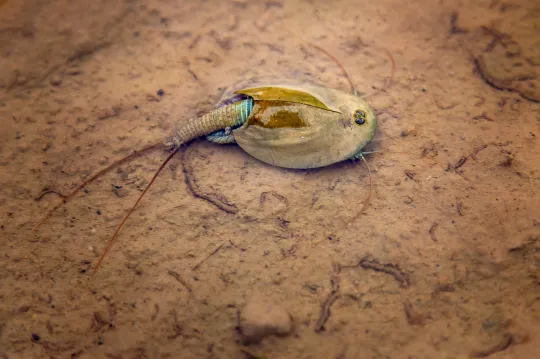What are the three-eyed ‘dinosaur shrimp’ resurfacing after Burning Man?
These curious critters were awoken in the Nevada desert after intense flooding upended Burning Man 2023. Here’s what you need to know about them
Your support helps us to tell the story
From reproductive rights to climate change to Big Tech, The Independent is on the ground when the story is developing. Whether it's investigating the financials of Elon Musk's pro-Trump PAC or producing our latest documentary, 'The A Word', which shines a light on the American women fighting for reproductive rights, we know how important it is to parse out the facts from the messaging.
At such a critical moment in US history, we need reporters on the ground. Your donation allows us to keep sending journalists to speak to both sides of the story.
The Independent is trusted by Americans across the entire political spectrum. And unlike many other quality news outlets, we choose not to lock Americans out of our reporting and analysis with paywalls. We believe quality journalism should be available to everyone, paid for by those who can afford it.
Your support makes all the difference.Who would have thought a small, yet peculiar creature could stir up such a scene in the Nevada Desert?
After heavy rains from Tropical Storm Hilary turned a dry desert into a mud pit, revellers at the Burning Man Festival were left trapped on site.
Footage on social media showed thousands of festivalgoers in the Black Rock Desert in damp, wet and muddy conditions.
And now, slowly marking its territory and sparking much discourse is a group of strange organisms knwon as the three-eyed “dinosaur shrimp”.
But should we be worried about these critters wriggling their way out in such a muddy scene?

Here is everything you need to know about the three-eyed “dinosaur shrimp” - formally known as Triops.
What are Triops?
Triops are a group of freshwater crustaceans commonly called tadpole shrimp or dinosaur shrimp, according to Live Science.
They have flat faces, a scaly tale and look like ancient, armoured tadpoles. The small creatures also have two main compound eyes and a third simple organ called an ocellus eye that helps them detect changes in light and infrared waves. The word ‘Triops’ means “three-eyes” in Greek.
The animals are not considered to be shrimps, but just like shrimp these small figures live in water.
In fact, Triops can adapt to an “extreme life in temporary freshwater or slightly salty pools that may only last a few weeks before drying out,” Live Science explains on its website. They can lay dormant for years in extreme drought conditions before coming alive when the wet comes.
The small critters grow to be no more than a few inches in length, so do not fear as they pose no threat to humans Instead, they prefer to feed on plant matter, algae and even mosquito larvae.
Are Triops considered to be dinosaurs?
According to Central Michigan University, Triops have had the same appearance since they first emerged in the Devonian period which is around 419 to 359 million years ago. They are known to be one of the oldest little creatures on earth.
Live Science said this has led some people to call the creatures “living fossils” a term that is also used to describe deep sea fish called coelacanths and horseshoe crabs – which also look quite similar to Triops.
These mini creatures are also known to be relatives of the oldest living creature, Triops cancriformis, Triops are among the fold, which is why Triops have the nickname “dinosaur shrimp”.
However, a 2013 study of Triop DNA, which was published in the journal PeerJ, found that the current species evolved within the last 25 million years.
"Living fossils evolve like any other organism, they just happen to have a good body plan that has survived the test of time," study lead author Africa Gómez, an evolutionary biologist at the University of Hull in England, said in a statement at the time.
Where do these creatures live?
Triops are found in Australia, Europe, Northern Asia, Africa, the US and many other countries.
The Integrated Taxonomic Information System (ITIS) recognises 13 different species in the Triops genus.
This includes the Australian tadpole shrimp called Triops australiensis, Triops emeritensis in Europe and northern Asia, and Triops maximus in Africa.
In the US there are two native species: Newberry tadpole shrimp (Triops newberryi) and summer tadpole shrimp (Triops longicaudatus).
Summer tadpole shrimp can be found throughout the US, except for Alaska.




Join our commenting forum
Join thought-provoking conversations, follow other Independent readers and see their replies
Comments